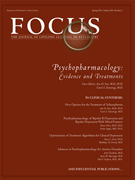“When should you begin to use a newly approved medication?”
Reply from Alan J. Gelenberg, M.D.
Someday the practice of psychiatry will become “personalized.” We will understand the physiological abnormalities that underlie the pathology of thought, mood, and perception. Interventions will target misguided proteins and receptors, thereby restoring balance to perturbed neural networks. Treatment will be tailored to each patient’s unique pathology and, like the current situation with some cancers, treatment effectiveness will improve and toxicity will diminish. Today, however, psychiatrists prescribe drugs that affect multiple brain and body systems to patients with biologically heterogeneous syndromes. When one fails to work or is poorly tolerated, we turn to another, then another, often with multidrug “cocktails.”
Pharmaceutical manufacturers are understandably reluctant to wager a billion dollars on developing a first-in-class paradigm-shifting medicine. More commonly, they acquire a new, patentable moiety with minimal differences from existing drugs. The Federal Drug Administration’s bar is set relatively low: accepting proof of efficacy against placebo and relative safety in healthy nonelderly adult patients without psychiatric, substance abuse, or medical comorbidities, exposed for relatively short periods. With differences among available treatments typically small, the spinmasters work hard to justify added cost in the absence of compelling data. Pharmaceutical companies bet on marketers to work magic via promotional talks, small gifts to doctors, office visits from attractive representatives, and glossy advertisements. This strategy usually is effective and, from a business perspective, has a good return on investment.
Marketers focus on modest pharmacologic differences, often of doubtful clinical relevance, between their new agent and the older ones. They obtain endorsements from “key opinion leaders,” who point out the legitimate unmet need in the treatment of psychosis, depression, insomnia, or other psychiatric conditions, the limitations and burdens of existing treatments, and then, with a leap of faith and logic, declare an “ipso facto” need for the new, expensive medication.
Today’s treatments for depression are far from adequate. But we must look beyond a marketer’s claim, for instance, that a presumed mechanism of action makes a new antidepressant faster acting or less likely to cause sexual complaints. The relevant question for us, the prescribers, is whether randomized controlled trials have actually shown the new costly drug to be superior in those domains to less expensive, older medications with established track records.
Or, consider insomnia, a common complaint to psychiatrists and primary care physicians. Everyone wants a hypnotic drug that rapidly facilitates physiologic sleep, with no “hangover” of cognitive or motor side effects. However, studies in experimental animals and fancy graphics of the brain do not make that case. Prescribing physicians need evidence of sound sleep—objectively and subjectively—and carefully assessed motor and cognitive function the next morning in human subjects, preferably with a comparison against standard agents.
When a new drug is introduced, it has been subjected to exhaustive reviews of clinical and laboratory data in premarketing trials. Generally, only a few thousand healthy subjects have been exposed to it, usually for months to a year. Once marketed, the drug will be taken by hundreds of thousands of patients—young and old, some with comorbities, many abusing drugs and alcohol, and taking a host of other medicines—for years or even decades. Also, we may not fully understand the dose-response curves for a new drug’s therapeutic and adverse effects for years after its introduction. Initial recommendations on dosing, interactions, and side effects typically evolve over a decade or more.
So, where does that leave us? Some patients have failed a multitude of standard therapies and call out for relief. These patients are tempting candidates for a new drug. First, we should consider alternate approaches that may have an even higher probability of success—including cognitive-behavioral and other psychotherapies or neuro-modulation techniques. Personally, I prefer to delay a year or so before adopting a new medicine for routine prescribing—waiting for news of the side effects, toxicities, and important clinical nuances that often emerge only when the drug has been used in large numbers of complex patients across a broad age range. Letters-to-editors are important sources of such information, along with advertisement-free publications, such as The Medical Letter.
One of my medical school instructors admonished his students to be therapeutic skeptics, but not nihilists. I have always embraced that creed and hope these thoughts stay true to it.

